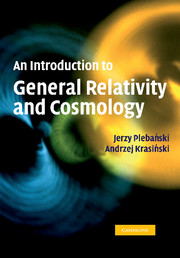1 - How the theory of relativity came into being (a brief historical sketch)
Published online by Cambridge University Press: 01 March 2010
Summary
Special versus general relativity
The name ‘relativity’ covers two physical theories. The older one, called special relativity, published in 1905, is a theory of electromagnetic and mechanical phenomena taking place in reference systems that move with large velocities relative to an observer, but are not influenced by gravitation. It is considered to be a closed theory. Its parts had entered the basic courses of classical mechanics, quantum mechanics and electrodynamics. Students of physics study these subjects before they begin to learn general relativity. Therefore, we shall not deal with special relativity here. Familiarity with it is, however, necessary for understanding the general theory. The latter was published in 1915. It describes the properties of time and space, and mechanical and electromagnetic phenomena in the presence of a gravitational field.
Space and inertia in Newtonian physics
In the Newtonian mechanics and gravitation theory the space was just a background – a room to be filled with matter. It was considered obvious that the space is Euclidean. The masses of matter particles were considered their internal properties independent of any interactions with the remaining matter. However, from time to time it was suggested that not all of the phenomena in the Universe can be explained using such an approach. The best known among those concepts was the so-called Mach's principle. This approach was made known by Ernst Mach in the second half of the nineteenth century, but had been originated by the English philosopher Bishop George Berkeley, in 1710, while Newton was still alive.
- Type
- Chapter
- Information
- Publisher: Cambridge University PressPrint publication year: 2006



